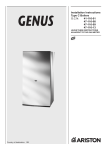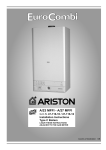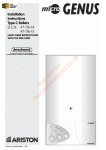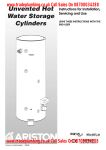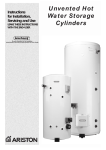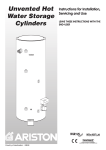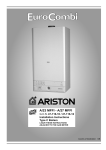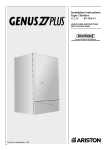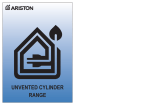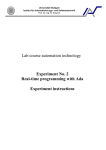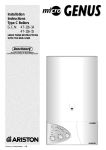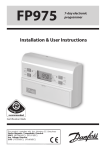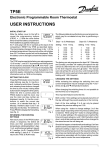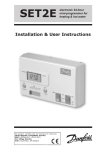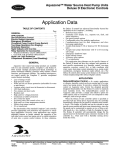Download Ariston 41-116-01 Boiler User Manual
Transcript
Installation Instructions Type C Boilers G.C.N: 41-116-01 47-116-08 47-116-09 47-116-13 LEAVE THESE INSTRUCTIONS ADJACENT TO THE GAS METER Country of destination: GB TABLE OF CONTENTS 1. GENERAL INFORMATION 1.1 General Instructions 1.2 Technical Information 1.3 Overall View 2. INSTALLATION 2.1 2.2 2.3 2.4 2.5 2.6 2.7 2.8 2.9 2.10 2.11 2.12 Reference Standards Siting the Appliance Overall Dimensions Clearances Mounting the Appliance Electrical Connection Gas Connection Water Connections Flue Connection Room Thermostat Connection Electrical/System Diagrams Water Circuit Diagrams 3. COMMISSIONING 3.1 3.2 3.3 3.4 3.5 3.6 3.7 3.8 3.9 Initial Preparation Removing the Casing Control Panel Initial Start-up Operational Adjustments Combustion Analysis Fume Discharge Monitoring Boiler Safety Systems Draining the System 4. GAS ADJUSTMENTS - Gas Adjustment Table 4.1 Changing the Type of Gas 5. MAINTENANCE 6. MISCELLANEOUS 6.1 Wiring Diagram for Two Heating Zones 6.2 Wiring Diagram for Connection to Ariston Unvented Cylinder 2 B004 1. GENERAL INFORMATION This manual is an integral and essential part of the product. It should be kept with the appliance so that it can be consulted by the user and our authorised personnel. Please carefully read the instructions and notices about the unit contained in this manual, as they provide impor tant information regarding the safe installation, use and maintenance of the product. For operating instructions please consult the separate User’s Manual. User’s Manual 1.1 General Information Read the instructions and recommendations in these Installation Instructions carefully to ensure proper installation, use and maintenance of the appliance. Keep this manual in a safe place. You may need it for your own reference while our Servicing Centre technicians or your installer may need to consult it in the future. This is a combined appliance for the production of central heating (C.H.) and domestic hot water (D.H.W.). This appliance must be used only for the purpose for which it is designed. The manufacturer declines all liability for damage caused by improper or negligent use. No asbestos or other hazardous materials have been used in the fabrication of this product. Before connecting the appliance, check that the information shown on the data plate and the table on pages 4-5 comply with the electric, water and gas mains of the property. You will find the data plate on the reverse of the control panel. The gas with which this appliance operates is also shown on the label at the bottom of the boiler. Do not install this appliance in a damp environment or close to equipment which spray water or other liquids. Do not place objects on the appliance. Do not allow children or inexperienced persons to use the appliance without supervision. If you smell gas in the room, do not turn on light switches, use the telephone or any other object which might cause sparks. Open doors and windows immediately to ventilate the room. Shut the gas mains tap (on the gas meter) or the valve of the gas cylinder and call your Gas Supplier immediately. If you are going away for a long period of time, remember to shut the mains gas tap or the gas cylinder valve. Always disconnect the appliance either by unplugging it from the mains or turning off the mains switch before cleaning the appliance or carriyng out maintenance. In the case of faults or failure, switch off the appliance and turn off the gas tap. Do not tamper with the appliance. For repairs, call your local Authorised Servicing Centre and request the use of original spare parts. For in-guarantee repairs contact MTS (GB) Limited Check the following at least once a year: 1 - Check the seal of water connections, replacing the gaskets if necessary. 2 - Check the seal of the gas connections, replacing the gaskets if necessary. B004 3 3 - Check the general condition of the appliance and of the combustion chamber visually. 4 - Visual check of the combustion: clean burners if necessary. 5 - With reference to point 3, dismantle and clean the combustion chamber if necessary. 6 - With reference to point 4, dismantle and clean the injectors if necessary. 7 - Visual check of the primary heat exchanger: - check for overheating of the exchangers fins; - clean the exhaust side of the exchanger and fan if necessary. 8 - Regulate the gas pressure, ignition pressure, partial flame, maximum flame. 9 - Check proper operation of the heating safety system: - maximum safety temperature; - maximum safety pressure. 10 - Check the proper operation of the gas safety system: - gas or flame safety device; - gas valve safety device. 11 - Check that the electrical connections have been made in compliance with the instructions shown in the Installation Instructions. 12 - Check the efficiency of the hot water supply (flow and temperature). 13 - Check general operation of the appliance. 14 - Check the exhaust system for the combustion products. 1.2 Technical Information 23 MFFI 27 MFFI 27 RFFI SYSTEM 30 MFFI 25.6/11.0 23.1/9.2 90.2 87.8 1.2 8.6 0.4 59 1.15 2.72/3.32 0.32/0.39 2.02/2.00 29.8/12.0 27.3/10.1 91.6 88.3 1.3 7.1 0.4 62 1.4 3.16/3.86 0.37/0.45 2.35/2.32 29.8/12.0 27.3/10.1 91.6 88.3 1.3 7.1 0.4 62 1.4 3.16/3.86 0.37/0.45 2.35/2.32 33.0/12.0 30.3/10.2 92.0 88.6 1.4 6.6 0.4 61 1.4 3.49/4.05 0.41/0.47 2.60/2.57 °C % 137 5.8 128 6.6 128 6.6 135 7.5 O2 Content % 9.2 8.0 8.0 8.0 CO Content Minimum Ambient Temperature Head Loss on Water Side (max) (³T=20°C) Residual Head of System Heating Temperature Domestic Hot Water Temperature D.H.W. Flow Rate ³T=35°C D.H.W. Flow Rate ³T=35°C D.H.W. Flow Minimum Rate Pressure of Domestic Hot Water Expansion Vessel Capacity Expansion Vessel Pre-load Pressure Maximum Water Content in System Maximum Heating Pressure Nominal Pressure Natural Gas (G20-G25) Liquid Gas (G30-G31) Electrical Supply Power Consumption Protection Grade of Electrical System Internal Fuse Rating Weight ppm °C mbar bar max/min °C max/min °C l/min gal/min l/min max/min bar l bar l bar mbar mbar V/Hz W IP 32 +5 200 0.25 82/42 56/36 9.5 2.1 2.6 6/0.2 7 1 145 3 20-25 30-37 230 / 50 150 X4D FAST 2 AT 47 34 +5 200 0.25 82/42 56/36 11.2 2.5 2.6 6/0.2 7 1 145 3 20-25 30-37 230 / 50 190 X4D FAST 2 AT 47 34 +5 200 0.25 82/42 ----------7 1 145 3 20-25 30-37 230 / 50 190 X4D FAST 2 AT 46.5 49 +5 200 0.25 82/42 56/36 12.3 2.7 2.6 6/.02 7 1 145 3 20-25 30-37 230 / 560 190 X4D FAST 2 AT 47 47-116-08 47-116-09 41-116-01 47-116-13 CE Certification Heat Input Heat Output Efficiency of Nominal Heat Input Efficiency at 30% of Nominal Heat Input Heat Loss to the Casing (³T=50°C) Flue Heat Loss with Burner Operating Flue Heat Loss with Burner Off Maximum Discharge of Fumes (G20-G25) Residual Discharge Head Consumption at Nominal Capacity (G20-G25) Gas Consumption after 10 Minutes* (15°C, 1013 mbar) (G30-G31) Temp. of exhaust fumes at nominal capacity (G20-G25) CO2 Content G.C. Number *Calculated at 70% maximum output 4 max/min kW max/min kW % % % % % Kg/h mbar m3/h m3 Kg/h Kg B004 1.3 Overall View GENUS 23/27/30 MFFI GENUS 27 RFFI SYSTEM Fig. 1.1 Legend: 1. 2. 3. 4. 5. 6. 7. 8. 9. 10. 11. 12. 13. 14. 15. 16. 17. 18. 19. 20. 21. 22. 23. 24. B004 Flue Connector Combustion Chamber Hood Main Heat Exchanger Combustion Chamber Insulation Panel Burner Expansion Vessel Overheat Thermostat Spark Generator Diverter Valve (MFFI) Motorised Valve (RFFI) Main Circuit Temperature Probe Main Circuit Flow Switch Domestic Hot Water Temperature Probe Diverter Valve Microswitch Filter Seat Drain Valve Secondary Heat Exchanger Safety Valve (3 bar) Circulation Pump with Automatic Air Release Valve Gas Valve Detection Electrodes Ignition Electrodes Fan Venturi Air Pressure Switch 5 2. 2.1 INSTALLATION Reference Standards The technical information and instructions provided herein below are intended for the installer so that the unit may be installed correctly and safely. The installation and initial startup of the boiler must be by a CORGI Approved Installer in compliance with the installation standards currently in effect, as well as with any and all local health and safety standards i.e. CORGI. This appliance must be installed by a competent installer in accordance with the current Gas Safety (installation & use) Regulations The installation of this appliance must be in accordance with the relevant requirements of the current Gas Safety (installation & use) Regulations, the Local Building Regulations, the current I.E.E. Wiring Regulations, the byelaws of the local water authority, and in Scotland, in accordance with the Building Standards (Scotland) Regulation and Health and Safety document No. 635 “Electricity at work regs. 1989”. Installation should also comply with the following British Standard Codes of Practice: Low pressure pipes BS 6891 Boilers of rated input not exceeding 60 kW BS 6798 Forced circulation hot water system BS 5449 Installation of gas hot water supplies for domestic purposes ( 2nd family gases) BS 5546 Flues BS 5440-1 Air supply BS 5440-2 2.2 Siting the Appliance 1988 1987 1990 1990 1990 1989 The appliance may be installed in any room or indoor area, although particular attention is drawn to the requirements of the current I.E.E. Wiring Regulations, and in Scotland, the electrical provisions of the Building Regulations applicable in Scotland, with respect to the installation of the combined appliance in a room containing a bath or shower. Where a room-sealed appliance is installed in a room containing a bath or shower the boiler and any electrical switch or appliance control, utilising mains electricity should be situated so that it cannot be touched by a person using the bath or shower. The location must permit adequate space for servicing and air circulation around the appliance as indicated in paragraph 2.4. The location must permit the provision of an adequate flue and termination. For unusual locations special procedures may be necessary. BS 6798-1987 gives detailed guidance on this aspect. A compartment used to enclose the appliance must be designed specifically for this purpose. No specific ventilation requirements are needed for an installation within a cupboard This appliance is not suitable for outdoor installation. The type C appliances (in which the combustion circuit, air vent intake and combustion chamber are air-tight with respect to the room in which the appliance is installed) can be installed in any type of room. There are no limitations with respect to ventilation and the volume of the room itself. The boiler must be installed on a solid, permanent wall to prevent access to the electrical parts (when live) through the aperture on the back frame. 6 B004 GENUS 23/27/30 MFFI Overall Dimensions 890 2.3 (A-B-D-E) (C) GENUS 27 RFFI SYSTEM 5 38 465 30 A = Central Heating Flow (3/4”) B = Domestic Hot Water Outlet (1/2”) C = Gas Inlet (3/4”) D = Domestic Cold Water Inlet (1/2”) E = Central Heating Return (3/4”) F = Cylinder Flow (3/4”) G = Cylinder Return (3/4”) 99 85 99 (F - G) 155 132 AF 67 65 49 Legend: (A - D - E) (C) 208 C DGE Fig. 2.1 2.4 Clearances In order to allow for access to the interior of the boiler for maintenance purposes, the boiler must be installed in compliance with the clearance requirements indicated in the diagram below. GENUS 27 RFFI SYSTEM 160 197 400 110 GENUS 23/27/30 MFFI 60 60 0 nx-5 ai3 m 450 300 Fig. 2.2 B004 7 2.5 Mounting the Appliance Fasten the boiler in place using the template and anchors supplied with the unit. It is highly recommended that a spirit level be used to position the boiler so that it is perfectly level. For additional information, please consult the instructions contained in the connection kit and the flue kit. 2.6 Electrical Connection For safety purposes, have a competent person carefully check the electrical system in the property, as the manufacturer will not be held liable for damage caused by the failure to earth the appliance properly or by anomalies in the supply of power. Make sure that the residential electrical system is adequate for the maximum power absorbed by the unit, which is indicated on the rating plate. In addition, check that the section of cabling is appropriate for the power absorbed by the boiler. The boiler operates with alternating current, as indicated in the technical data table (1.2), where the maximum absorbed power is also indicated. Make sure that the connections for the neutral and live wires correspond to the indications in the diagram. The appliance electrical connections are situated on the reverse of the control panel (see the servicing manual for further information) Fig. 2.3 Important! In the event that the power supply cord must be changed, replace it with one with the same specifications. Make the connections to the terminal board located within the control panel, as follows: - The yellow-green wire should be connected to the terminal marked with the earth symbol; make sure to re-use the ferrule mounted on the other supply cord; - The blue wire should be connected to the terminal marked “N”; - The brown wire should be connected to the terminal marked “L”. Note: The diagrams for the electrical system are indicated in section 2.11. Warning, this appliance must be earthed. External wiring to the appliance must be carried out by a qualified technician and be in accordance with the current I.E.E. Regulations and applicable local regulations. The Genus range of boilers are supplied for connection to a 230 V~ 50 Hz supply. The supply must be fused at 3 A. The method of connection to the electricity supply must facilitate complete electrical isolation of the appliance, by the use of a fused double pole isolator having a contact separation of at least 3 mm in all poles or alternatively, by means of a 3 A fused three pin plug and unswitched shuttered socket outlet both complying with BS 1363. The point of connection to the Electricity supply must be readily accessible and adjacent to the appliance unless the appliance is installed in a bathroom when this must be sited outside the bathroom. 2.7 8 Gas Connection The local gas supplier contractor connects the gas meter to the service pipe. If the gas supply for the boiler serves other appliances ensure that an adequate supply is available both to the boiler and the other appliances when they are in use at the same time. Pipe work must be of an adequate size. Pipes of a smaller size than the boiler inlet connection should not be used. B004 2.8 Water Connections View of the Boiler Connections GENUS 23/27/30 MFFI GENUS 27 RFFI SYSTEM C C A B D E A D I I F Legend E G Fig. 2.4 A = Central Heating Flow B = Domestic Hot Water Outlet C = Gas Inlet D = Domestic Cold Water Inlet E = Central Heating Return F = Cylinder Flow G = Cylinder Return I = Safety Valve Fig. 2.5 Fitting the connection kit to the Genus 27 RFFI System only. It will be noted that the kit has two connections not required for this boiler i.e. the domestic cold inlet “E” and the domestic hot water outlet “B” (see fig. 2.4). Although the cold water main supply must be connected to the isolation valve for the purpose of operating the fillingloop, the isolation valve is NOT connected to the boiler and should be left in the OFF position. The D.H.W. outlet is capped-off on the boiler, therefore not requiring the isolation valve to be used. The Genus 27 RFFI System has 2 x 3/4" B.S.P. male threads for the cylinder flow and return. It is recommended that 2 x 22mm x 3/4" female iron fittings (not supplied) be used on these connections (using P.T.F.E. tape), before the boiler is mounted on the wall. B004 Central Heating Detailed recommendations are given in BS 6798:1987 and BS 5449-1:1990, the following notes are given for general guidance. Pipe Work: Copper tubing to BS EN 1057:1996 is recommended for water pipes. Jointing should be either with capillary soldered or compression fittings. Where possible pipes should have a gradient to ensure air is carried naturally to air release points and water flows naturally to drain taps. The appliance has a built-in automatic air release valve, however it should be ensured as far as possible that the appliance heat exchanger is not a natural collecting point for air. Except where providing useful heat, pipes should be insulated to prevent heat loss and avoid freezing. Particular attention should be paid to pipes passing through ventilated spaces in roofs and under floors. By-pass: The appliance includes an automatic by-pass valve, which protects the main heat exchanger in case of reduced or interrupted water circulation through the heating system, due to the closing of thermostatic valves or cock-type valves within the system. System Design: This boiler is suitable only for sealed systems. Drain Cocks: These must be located in accessible positions to permit the draining of the whole system. The taps must be at least 15mm nominal size and manufactured in accordance with BS 2870:1980. Safety Valve Discharge: The discharge should terminate facing downwards on the exterior of the building in a position where discharging (possibly boiling water & steam) will not create danger or nuisance, but in an easily visible position, and not cause damage to electrical components and wiring. The discharge must not be over an entrance or a window or any other type of public access. 9 Air Release Points: These must be fitted at all high points where air naturally collects and must be sited to facilitate complete filling of the system. The appliance has an integral sealed expansion vessel to accommodate the increase of water value when the system is heated. It can accept up to 7 l (1.5 gal) of expansion water. If the heating circuit has an unusually high water content, calculate the total expansion and add an additional sealed expansion vessel with adequate capacity. Mains Water Feed - Central Heating: There must be no direct connection to the mains water supply even through a non-return valve, without the approval of the Local Water Authority. Filling: A temporary method for initially filling the system and replacing lost water during servicing and initial filling (in accordance with Water Supply Byelaw 14), is provided as an intergal part of the connection kit (see fig. 2.5). The flexible hose must be removed once the system has been filled. The D.H.W. inlet valve on the connection kit has two postions, one for winter and one for the summer. This enables the flow-rate through the appliance to be adjusted so that a sensible D.H.W. temperature may be achieved throughout the year. Domestic Water The domestic water must be in accordance with the relevant recommendation of BS 5546:1990. Copper tubing to BS EN 1057:1996 is recommended for water carrying pipe work and must be used for pipe work carrying drinking water. Residual Head of the Boiler 27/30 kW 23 kW 2.9 10 Flue Connections Flue System The provision for satisfactory flue termination must be made as described in BS 5440-1. The appliance must be installed so that the flue terminal is exposed to outdoor air. The terminal must not discharge into another room or space such as an outhouse or lean-to. It is important that the position of the terminal allows a free passage of air across it at all times. The ter minal should be located with due regard for the damage or discolouration that might occur on buildings in the vicinity. In cold or humid weather water vapour may condense on leaving the flue terminal. The effect of such “steaming” must be considered. If the terminal is less than 2 metres above a balcony, above ground or above a flat roof to which people have access, then a suitable terminal guard must be fitted. When ordering a terminal guard, quote the appliance model number. B004 A suitable terminal guard is available from: TOWER FLUE COMPONENTS Morley Road Tonbridge Kent TN9 1RA The minimum acceptable spacing from the terminal to obstructions and ventilation openings are specified in Fig. 2.6 BC F G F D HI J A E L K TERMINAL POSITION mm A - Directly below an open window or other opening B - Below gutters, solid pipes or drain pipes C - Below eaves D - Below balconies or car-port roof E - From vertical drain pipes and soil pipes F - From internal or external corners G - Above ground or below balcony level H - From a surface facing a terminal I - From a terminal facing a terminal J - From an opening in the car port (e.g. door, window) into dwelling K - Vertically from a terminal in the same wall L - Horizontally from a terminal in the same wall 300 75 200 200 75 300 300 600 1200 G Fig. 2.6 1200 1500 300 The boiler is designed to be connected to a coaxial flue discharge system. Ø 60/100 mm Fig. 2.7 B004 11 In addition, it is also possible to use a split system by fitting a special adapter to the flue discharge collar and using one of the apertures for the air vent intake located on the top part of the combustion chamber (A). Ø 80 mm A A A Ø 80 mm Fig. 2.8 This procedure must be done as follows: 1 - Remove the air vent intake you want to use, in the area indicated in Fig. 2.9, by breaking the perforated ring. 2 - Use a tool to grasp the lid and remove it completely. 3 - Clean any burrs or sharp edges with a knife or an appropriate tool. A Fig. 2.9 12 Fig. 2.10 B004 In Fig. 2.11 below, several different types of flue systems are shown. For additional information regarding the flue accessories, please consult the Flue Pipe Accessories manual. Fig. 2.11 B004 13 Coaxial Systems Twin Pipe Systems Exhaust Type 30 kW Use of Restrictor on Discharge Side L * < 0.5 m 27 kW L * < 0.5 m 23kW L * < 0.5 m 45 mm 30 kW ø 60/100 42 mm 23kW 27 kW 3m Diameter of Pipes (mm) 4m L * < 0.5 m Maximum Extension Exhaust/Air 23 kW - 27 kW 30kW C12 (xx) L * < 0.5 m L > 4.5 m L * < 0.5 m L > 6.5 m L > 4.5 m ø 60/100 L > 4.9 m L > 6.5 m L > 4.5 m 3m L < 7.5 m L > 4.9 m L > 6.5 m L > 4.5 m 4m L<5m L < 7.5 m L > 4.9 m L < 5.3 m C32 (xx) L<7m L<5m L < 7.5 m L > 4.9 m L * < 0.5 m 30 kW ø 80 L<7m L<5m L < 7.5 m L * < 0.5 m 27 kW 50 m ø 80 L<7m L<5m L * < 0.5 m 23 kW 46 m 50 m ø 80 L<7m ø 60/100 54 m 46 m 50 m ø 80 3m C12 (xy) 54 m 46 m 15 m 4m C32 (xy) 54 m 17 m C42 (xx) C42 (xy) 17 m Risk of Condensation Forming (*) L = Length of Piping 14 C52 (xy) In calculating the lengths of the pipes, the maximum length must also take into consideration the values for the exhaust/air intake end terminals, as well as 90° elbows for coaxial systems. The C52 types must comply with the following requirements: 1. The discharge/intake vent pipes must have the same diameter of ø 80 mm. 2. The maximum combined flue length is 17 m for Models Genus 23/27 MFFI/RFFI and 15 m for Model Genus 30 MFFI. In this case the minimum length for the air intake pipe is 1 meter ; the maximum length of ver tical exhaust pipe must be a maximum of 12 m. 3. If an elbow is inserted into the discharge/ventilation system, the calculation of the overall extension must take into consideration the values for each curve, as indicated in the table. 4. The exhaust pipe must extend at least 0.5 m above the ridge of the roof if it is located on a side other than that for the air intake (this is not obligatory if the exhaust and air intake pipes are located on the same side of the building). B004 2.10 Room Thermostat Connection In order to perform this procedure, remove the boiler casing as indicated in section 3.2. Then proceed as follows: 1 Remove the two screws “A” in order to remove the cover, release the two clips “B” and lift and rotate down the control panel box. 2 Open the cover “C” on the left hand side of the compartment. 3 Insert the wire for the connection of the room thermostat into the cable clamp “D”, as indicated in photo 3. 1 2 B 3 D C A 4 Remove the grommet “E” shown in the photo 4, make a hole in it and pass the room thermostat wire through. 5 Remove the link located in the terminal block and connect the wire. 6 Replace the grommet and the terminal block to their original positions, close the cover on the grommet compartment and fasten the wire-clamp “D” in place. 7 If a remote time clock is to be fitted, disconnect the integral time clock plug from the P.C.B. 8 Using a volt-free switching time clock, connect the switching wires from the time clock following points 1-6 above. 9 If using a time clock and room thermostat, these must be connected in series as per points 1-8 above. Note: Only a two-wire type room thermostat can be used. For details on fitting the D.H.W. probe (Genus 27 RFFI only), please consult the separate instruction sheet supplied with the probe. An anti-frost device is built-in to the appliance’s electronic regulation system. 4 5 E B004 6 D 15 2.11 Electrical Diagram Legend: AT BT A B C D E F G H I J K L M N O P Q R S T U V W X Y Z Aa = = = = = = = = = = = = = = = = = = = = = = = = = = = = = High Voltage P.C.B. Low Voltage P.C.B. Remote Connector Kit Flame Failure L.E.D. Insufficient Water Pressure L.E.D. Water Temperature Indicator L.E.D.s Overheat Thermostat Warning L.E.D. System Reset Button Selector Knob for Operating Mode Domestic Hot Water Temp. Adjustment Central Heating Temp. Adjustment Wire Connector for Room Thermostat Connector for Total Check System Selector for Local/Remote Control Anti-cycling Device Adjustment for Heating Soft-light Adjustment Max Heating Temperature Adjustment Time Clock Connection On/Off L.E.D. On/Off Switch Interface Wire for P.C.B.s Relay Motorised Valve Ignitor Relay Gas Valve Relay Fan Relay Circulation Pump Relay Selector TCS2 Link for Continuous Pump Run Adaptor (British Gas use only) A01 = A02 = A03 = A04 = A05 = A06 = A07 = A08 = A09 = A10 = A11 = A12 = Air Pressure Switch Fan Gas Valve Ignitor Motorised Valve Circulation Pump Flame Detector Earth Terminal Flame Detection Circuit Flame Indicator L.E.D. Transformer Filter B01 = B02 = B03 = B04 = Over Heat Thermostat External Thermostat Gas Valve Modulator D.H.W. Probe Sensor Cylinder (RFFI SYSTEM models only) B05 = B06 = B07 = Heating Sensor Pressure Switch for Heating Circuit Microswitch for Diverter Valve (MFFI models only) Colours Gry Rd Bl Grn/Yll Wh Brn Blk Wh/Rd 16 = Grey = Red = Blue = Yellow/Green = White = Brown = Black = White/Red B004 GENUS 23/27/30 MFFI Aa GENUS 27 RFFI SYSTEM Aa B004 17 GENUS 23/27/30 MFFI CN202 P GENUS 27 RFFI SYSTEM P 18 B004 2.12 Water Circuit Diagram GENUS 23/27/30 MFFI Legend 1. Air Pressure Switch 2. Fan 3. Main Heat Exchanger 4. Burner 5. Electronic Ignitor and Electronic Flame Detector 6. Gas Valve 7. Overheat Thermostat 8. Heating Sensor 9. Diverter Valve (MFFI) Motorised Valve (RFFI) 10. Main Flow Switch Including Safety Pressure Switch for Primary Circuit 11. Automatic By-pass 12. Microswitch for Diverter Valve 13. Sensor for Domestic Hot Water 14. Secondary Heat Exchanger 15. Domestic Water Inlet Filter 16. Drain Valve 17. Safety Valve GENUS 27 RFFI SYSTEM 18. Water Pressure Gauge 19. Circulation Pump with Automatic Air Valve 20. Expansion Vessel A. Central Heating Flow B. Domestic Hot Water Outlet C. Gas Inlet D. Domestic Cold Water Inlet E. Central Heating Return F. Cylinder Flow G. Cylinder Return B004 19 3. COMMISSIONING 3.1 Initial Preparation Preliminary electrical system checks to ensure electrical safety must be carried out by a competent person i.e. polarity, earth continuity, resistance to earth and short circuit. Filling the Heating System: Remove the panels of the case and lower the control panel (see point 3.2. for further information). Open the central heating flow and return cocks supplied with the connection kit. Unscrew the cap on the automatic air release valve one full turn and leave open permanently. Close all air release valves on the central heating system. Gradually open valve(s) at the filling point (filling-loop) connection to the central heating system until water is heard to flow, do not open fully. Open each air release tap starting with the lower point and close it only when clear water, free of air, is visible. Purge the air from the pump by unscrewing anticlockwise the pump plug and also manually rotate the pump shaft in the direction indicated by the pump label to ensure the pump is free. Close the pump plug. Continue filling the system until at least 1 bar registers on the pressure gauge. Inspect the system for water soundness and remedy any leaks discovered. Filling of the D.H.W. System: Close all hot water draw-off taps. Open the cold water inlet cock supplied with the connection kit. Open slowly each draw-off tap and close it only when clear water, free of bubbles, is visible Gas Supply: Inspect the entire installation including the gas meter, test for soundness and purge, all as described in BS 6891:1988. Open the gas cock (supplied with the connection kit) to the appliance and check the gas connector on the appliance for leaks. When the installation and filling are completed turn on the central heating system (sect. 3.4) and run it until the temperature has reached the boiler operating temperature. The system must then be immediately flushed through. The flushing procedure must be in line with BS 7593:1992 Code of practice for treatment of water in domestic hot water central heating systems. During this operation, we highly recommend the use of a central heating flushing detergent (Fernox Superfloc or equivalent), whose function is to dissolve any foreign matter that may be in the system. Substances different from these could create serious problems to the pump or other components. The use of an inhibitor in system such as Fernox MB-1 or equivalent is strongly recommended to prevent corrosion (sludge) damaging the boiler and system. Failure to carry out this procedure may invalidate the appliance warranty. 3.2 Removing the Casing 1 To dismantle the front part of the casing, proceed as follows: 1. Loosen the two screws “F” located on the bottom part of the boiler until the first thread on the screws appears; F 20 B004 2 3 4 2. Lift the front panel up until it stops after the click; 3. Remove the front panel from the rest of boiler casing; 4. Unhook the two cords from the location slots. 3.3 Control Panel GENUS 23/27/30 MFFI A - Ignition Lockout Reset Button/Safety (Overheat)Thermostat Reset B - Ignition Lockout L.E.D. C - Selector Knob for Summer/Winter/Flue Analysis Modes* D - Low System Water Level L.E.D. E - Temperature Adjustment Knob for Domestic Hot Water F - Heating System Thermometer G - Safety (Overheat)Thermostat GENUS 27 RFFI SYSTEM Intervention L.E.D. H - Adjustment Knob for Heating Temperature I - On/Off L.E.D. L - On/Off Switch O - System Pressure Gauge * Warning the flue analysis mode must only be selected by a qualified service engineer. B004 21 3.4 Initial Start-up The checks to be run before initial start-up are as follows: 1. Make sure that: - the screw on the automatic air valve has been loosened when the system is full; - If the water pressure in the system is below 1 bar, bring it up to the appropriate level; - Check to see whether the gas cock is closed; - Make sure that the electrical connection has been made properly and that the earth wire is connected to an efficient earthing system; - Supply power to the boiler by pressing the On/Off switch <L> - the L.E.D. “I” will turn on - turn the selector knob “C” to the <winter> setting. This will start the circulation pump. After 7 seconds, the boiler will signal a shutdown due to failure ignition. Leave the boiler as it is until all of the air has been bled from the lines. - Loosen the cap on the head of the pump to eliminate any air pockets; - Repeat the procedure for bleeding the radiators of air; - Open the taps for a brief period; - Check the system pressure and, if it has dropped, open the filling loop again to bring the pressure back up to 1 bar. 2. Check the exhaust flue for the fumes produced by combustion. 3. Make sure that all gate valves are open; 4. Turn on the gas cock and check the seals on the connections, including the one for the burner, making sure that the meter does not signal the passage of gas. Check the connections with a soap solution and eliminate any leaks. 5. Press the reset button “A” for the lighting system; the spark will light the main burner. If the burner does not light the first time, repeat the procedure. 6. Check the minimum and maximum pressure values for the gas going to the burner; adjust it if needed using the values indicated in the table in section 4. (See sect of the servicing manual). 3.5 Operational Adjustments The boiler was designed to make regulation easy. To access the adjustment and control area, simply remove the cover by unscrewing the screws “A” and “C” and lift up the small service panels “B1” and “B2” respectively. The first provides access to the control (low voltage) P.C.B., while the second makes it possible to work on the power supply P.C.B. A B1 B2 C The service panel “B2” also provides access to: - the power supply cord connector; - the fuses; - the selector knob for continuous operation of the circulation pump. The service panel “B1” also provides access to: - the potentiometer for regulating the ignition delay (anti-cycling) feature, which can be set from 0 to 2 minutes (factory set at 1 minute); 22 B004 - the potentiometer for regulating the soft-light feature, the setting for which can range from the minimum thermal power to the maximum: G20 G25 G30-31 5 mbar 18 mbar 19 mbar - the potentiometer for the maximum thermal power for the heating system, maximum thermal power setting (factory set at the maximum value, unless indicated otherwise on the adhesive sticker located in proximity to the potentiometer); - The connection to the diagnosis device (TCS-TCS2). 3.6 Combustion Analysis The boiler is designed to make it easy to analyse the combustion by-products. Using the especially designed apertures, readings can be taken on the temperature of the combustion by-products and of the combustion air, as well as of the concentrations of O2 and CO2, etc. The best maximum-power test conditions for the heating system are when the selector “C” is turned to the flue analysis setting. 3.7 B004 Fume Discharge Monitoring The discharge/ventilation of the exhaust fumes can be monitored to check for losses in general pressure in the system. This is done to eliminate the cause of lighting failure with the main burner not indicated by a shutdown status. With a differential manometer connected to the test socket on the combustion chamber, the DP value for the air pressure switch can be taken. The measured value should not be less than 10 mbar under maximum thermal power conditions (with the knob “C” on the flue test setting) in order for the unit to function properly and without interruption. 23 3.8 Boiler Safety Systems The boiler is equipped with the following safety systems (see section 3.3 for references): 1. - Ignition Failure This control signals an ignition failure on the burner 7 seconds after a lighting failure. The L.E.D. “B” will turn on to signal the shutdown status. The system can be reset by pressing and releasing the button “A” after checking to make sure that the gas valve is open. Repeat this process until the burner lights. 2. - Circulation Failure This control signals that the safety pressure switch on the primary circuit has not sensed a pressure of at least 1 bar within 40 seconds of the activation of the circulation pump, it shuts off the boiler and lights the L.E.D. “D” The system can be reset (after the pressure has been brought up to the proper level) by using the On/Off switch “L”. 3. - Overheating This control shuts off the boiler in the case where the primary circuit reaches a temperature in excess of 110°C. The L.E.D. “G” will come on to signal this shutoff status. After the system has been allowed to cool, the system can be reset by pressing the button “A”. 4. - Limescale Build-up This is an indirect control (actuated through the regulation of the temperature in the primary heat exchanger) on the formation of limescale in the secondary heat exchanger. Regardless of the flow rate and the temperature in the circuit for the domestic hot water, the temperature is limited to 62°C. 5. - Anti-frost Device The boiler is equipped with a device that automatically lights the main burner when the temperature in the delivery line to the system drops below 5°C. The boiler will continue to operate until the temperature in question reaches about 58°C. This device is activated on a properly operating boiler if: - the system pressure is between the acceptable values; - the power supply to the unit is on; - the unit is supplied with gas. This feature is enabled also when the boiler is in summer operating mode. 6. - Safety Shut-off At the start of every lighting phase, the P.C.B. performs a series of internal controls. If a malfunction occurs, the boiler will shutdown until the problem has been resolved. 3.9 Draining the System Draining the heating system. The heating system must be emptied as follows: - Turn off the boiler; -Open the drain valve for the system and place a container below to catch the water that comes out; - Empty the system at the lowest points (where present). If you plan on not using the heating system for an extended period of time, it is recommended that you add antifreeze with an ethylene glycol base to the water in the heating lines and radiators if the ambient temperature drops below 0°C during the winter. This makes repeated draining of the entire system unnecessary. Draining the domestic hot water system. Whenever there is the danger of the temperature dropping below the freezing point, the domestic hot water system must be drained as follows: - Turn off the general water valve for the household plumbing system; - Turn on all the hot and cold water taps; - Empty the remaining water from the lowest points in the system (where present). 24 B004 4. GAS ADJUSTMENTS CATEGORY II2H3+ Lower Wobbe Index (15°C;1013mbar) Nominal Delivery Pressure Minimum Delivery Pressure Methane Gas G20 MJ/m3h mbar mbar Liquid Butane Gas G30 45.67 20 17 Liquid Propane Gas G31 80.58 30 20 70.69 37 25 0.72 ---2.02 0.72 ---2.02 23 MFFI Main Burner: n. 13 jets (ø) Consumption (15°C; 1013mbar) Consumption (15°C; 1013mbar) Gas Cock Outlet Pressure max - min mm mc/h Kg/h 1.25 2.72 ---- mbar 11.4- 2.0 mc/h Kg/h 1.25 3.16 ---- mbar 11.4-2.0 mc/h Kg/h 1.30 3.49 ---- mbar 11.4-1.4 27.5 (*) - 5.0 35.0 (*) - 7.0 27 MFFI - 27 RFFI System Main Burner: n. 15 jets (ø) Consumption (15°C; 1013mbar) Consumption (15°C; 1013mbar) Gas Cock Outlet Pressure: max - min 0.72 ---2.35 0.72 ---2.32 (*) - 5.0 (*) - 7.0 0.77 ---2.60 0.77 ---2.57 (*) - 4.1 (*) - 5.6 30 MFFI Main Burner: n. 15 jets (ø) Consumption (15°C; 1013mbar) Consumption (15°C; 1013mbar) Gas Cock Outlet Pressure: max - min (1mbar = 10,197column of water) The outlet pressure of the gas cock is obtained by completely loosening the screw on the solenoid. The maximum pressure of the gas to the burner will be equal to the nominal delivery pressure minus the head loss within the gas valve. 4.1 Changing the Type of Gas CATEGORY II2H3+ Recommended Soft-light Pressure (mbar) B004 The boiler can be converted to use either methane (natural) gas (G20) or LPG (G30 - G31) by an Authorised Service Centre. The operations that must be performed are the following: 1. Replace the jets on the main burner (see table in section 4); 2. Adjust the maximum and minimum thermal capacity values for the boiler (see table in section 4); 3. Replace the gas rating plate; 4. Adjust the maximum thermal power setting; Methane Gas Liquid Butane Gas Liquid Propane Gas G20 G30 G31 5-5.5 17 - 18 18 - 19 25 5. Adjust the soft-light feature; 6. Adjust the delayed lighting feature for the heating system (can be set from 0 to 2 mins.). 5. 26 MAINTENANCE It is recommended that the following checks be made on the boiler at least once a year: 1 - Check the seals for the water connections; replacement of any faulty seals. 2 - Check the gas seals; replacement of any faulty gas seals. 3 - Visual check of the entire unit. 4 - Visual check of the combustion process or analysis of flue gas (see ref 3.6) and cleaning of the burners if needed. 5 - If called for by check no. 3, dismantling and cleaning of the combustion chamber. 6 - If called for by check no. 4, dismantling and cleaning of the injectors. 7 - Visual check of the primary heat exchanger: - check for overheating in the blade assembly; - clean the exhaust fan if needed. 8 - Adjustment of the flow rate of the gas: flow rate for lighting, partial load and full load. 9 - Check of the heating safety systems: - safety device for maximum temperature; - safety device for maximum pressure. 10 - Check of the gas safety systems: - safety device for lack of gas or flame ionisation (detection electrode); - safety device for gas cock. 11 - Check of the electrical connection (make sure it complies with the instructions in the manual). 12 - Check of domestic hot water production efficiency (delivery rate and temperature) 13 - Check of the general performance of the unit. 14 - General check of the discharge/ventilation of the combustion byproducts. B004 B004 240V MAINS INPUT (3 AMP) 3 8 2 2 T6360B ROOM THERMOSTAT ZONE 2 L 1 N 2 E 3 4 E 8 E 1 2 4 4 E E E 5 N N 3 L 4 N 7 6 L N N L L 3 L 6 L 6 Towerchron MP Link 1-4/6-11 ZONE 2 4 Randall 3020 P and 3060 4 3 E 1 0 1 0 4 1 1 E N 2 6 E E N HW HTG ON ON 1 L N N N 2 2 1 L 2 N L L L L L 1 1 2 ZONE 1 PROGRAMMER 3 Randall 922, 972 Link L-2-5 ACL LS522, LS722 Towerchron 2000 6 Towerchron FP Link 1-5/4-7-9 3 7 Sunvic ET 1451 Link 2-3-6 Sunvic DHP 2201 3 N • 3 ZONE 1 6 3 SWITCHMASTER 805, 900 Switchmaster 400, 600 4 E E E N L N L N L 1 Based on Honeywell controls BOILER Remove internal time clock plug from the the P.C.B. then connect room stat terminal block on the reverse of the boiler control panel (see section 2.10) to 9 + 10 on the junction box. PROGRAMMER 8 2 4 4 N 1 Switchmaster Symphony, Sonata L 2 BOILER ELECTRICAL SUPPLY CABLE ZONE 2 Sangamo 410 Form 1 Link 3-6 1 3 Randall 701, 702 Link L-6-5 Sangamo M5 Link 1-6 4 Randall 4033 Link 1-6 1 3 Randall 102/102 E Link 3-6 Potterton EP2000/3000 Link L-5 EP2001/3001 3 Landis & Gyr RWB20 Microgyr 3 3 Landis & Gyr RWB2 Glowworm Mastermind • 10 E • 9 4 3 1 GREEN/YELLOW • 7 Horstmann 425, 525, 527 Link L-2-5 9 10 L GREY ORANGE • 6 L 2 1 6 N 8 BLUE N BROWN Potterton Miniminder 4 1 4 • 5 3 • 4 A/27 MFFI - A/27 MFFI Genus 23-27-30 MFFI Genus 27 RFFI System 2 N 2 E • 1 5 5 TYPICAL JUNCTION BOX 2 3 3 3 Pegler Sunvic SP 50/100 (Link L-3) V4043H VALVE 10 GREEN/YELLOW 9 10 Drayton Tempus 7 L 4 1 9 ORANGE N T6360B ROOM THERMOSTAT 2 2 3 GREY 3 ZONE1 4 5 BLUE 6 BROWN 6 V4043H VALVE 1 Wiring Diagram for Two Heating Zones 2 6.1 ST 6400/ST 6300 ST 6200 3 3 MISCELLANEOUS 4 1 Honeywell ST 699B 1002 Link L-5-8 6 6. • 2 • 8 If a room thermostat is not required on Zone 1, insert a link between 4 + 5 on the junction box. If a room thermostat is not requied on Zone 2, insert a link between 6 + 8 on the junction box. 27 1 2 28 C/P Cylinder thermostat Thermal cut-out 1 C/P 1 8 P 6 2 Not used Sangamo 410 Form 1 Link 3-6 4 8 8 1 2 2 4 4 E E E E E E 4 4 N 7 5 N N N N N 3 3 L 6 6 L L L L L 4 Randall 3020 P and 3060 E E HTG ON E E N N N N 2 2 1 1 N N N N • 3 L L L L 1 1 2 2 L L L L PROGRAMMER 2 6 3 Randall 922, 972 Link L-2-5 10 4 6 Towerchron MP Link 1-4/6-11 10 3 6 Towerchron FP Link 1-5/4-7-9 3 ACL LS522, LS722 6 Sunvic DHP 2201 4 HW ON 7 Sunvic ET 1451 Link 2-3-6 1 1 4 Towerchron 2000 3 3 SWITCHMASTER 805, 900 Switchmaster 400, 600 1 Switchmaster Symphony, Sonata E A/27 MFFI - A/27 MFFI Genus 23-27-30 MFFI Genus 27 RFFI System 9 Remove internal time clock plug from the the P.C.B. then connect room stat terminal block on the reverse of the boiler control panel (see section 2.10) to 9 + 10 on the junction box. 2 N N N 3 E E E L L L 1 Based on Honeywell controls BOILER 10 BOILER ELECTRICAL SUPPLY CABLE PROGRAMMER 1 1 3 Sangamo M5 Link 1-6 4 1 Randall 102/102 E Link 3-6 Randall 701, 702 Link L-6-5 3 Potterton EP2000/3000 Link L-5 EP2001/3001 Randall 4033 Link 1-6 3 3 • 10 Potterton Miniminder 240V MAINS INPUT (3 AMP) Landis & Gyr RWB20 Microgyr 3 4 E • 9 3 2 Landis & Gyr RWB2 Glowworm Mastermind N 4 1 1 L • 7 Horstmann 425, 525, 527 Link L-2-5 3 L V4043H HOT WATER VALVE L GREEN/YELLOW • 6 N 10 N ORANGE 4 9 4 GREY • 5 3 2 3 BLUE 5 • 4 Drayton Tempus 7 8 ST 6400/ST 6300 ST 6200 BROWN 2 V4043H HEATING VALVE Pegler Sunvic SP 50/100 (Link L-3) 3 L 10 GREEN/YELLOW N 9 ORANGE • 1 3 TYPICAL JUNCTION BOX 6 2 GREY 1 5 BLUE 2 T6360B ROOM THERMOSTAT 3 BROWN 4 2 6 2 1 5 2 3 3 4 4 1 Honeywell ST 699B 1002 Link L-5-8 6 6.2 Wiring Diagram for Connection to Ariston Unvented Cylinder • 2 • 8 B004 NOTES B004 NOTES B004 30 31 B004 Merloni TermoSanitari SpA - Italy Commercial subsidiary: MTS (GB) LIMITED MTS Building Hughenden Avenue, High Wycombe Bucks HP13 5FT Telephone: (01494) 755600 Fax: (01494) 459775 Technical Service Hotline: (01494) 539579 B004 - Cod. 23 99 84 1259 111 - Stampa: bieffe RECANATI Manufacturer:
































